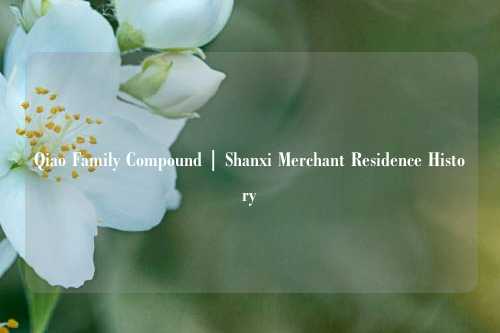Qiao Family Compound | Shanxi Merchant Residence History
The Rise of the Shanxi Merchants and the Qiao Family Compound
Nestled in the heart of Qiaojiawa Village in Shanxi Province, the Qiao Family Compound is a staggering example of the wealth and influence of the Shanxi merchants during the Ming and Qing dynasties. Often referred to as the "Forbidden City of Shanxi," this architectural marvel is a window into a bygone era, showcasing the opulence and ingenuity of one of China's most influential merchant clans.

The Shanxi merchants, or "Shanxi businessmen," were a powerful force in Chinese history, particularly during the Ming (1368–1644) and Qing (1644–1912) dynasties. They dominated trade in salt, tea, silk, and even banking, amassing vast fortunes that allowed them to commission elaborate residences like the Qiao Family Compound. These merchants were not only entrepreneurs but also patrons of the arts and architecture, leaving behind a legacy of stunning buildings that still captivate visitors today.
The Qiao Family Compound was built in the late Ming and early Qing periods, with construction spanning several generations. The compound is a labyrinth of interconnected courtyards, halls, and pavilions, each ly designed to reflect the wealth and status of the Qiao family. Its architecture is a blend of practicality and aesthetic beauty, with carvings, tiled roofs, and ornate decorations that highlight the skill of China's ancient artisans.
One of the most striking features of the Qiao Family Compound is its design. During a time when banditry and regional conflicts were common, the compound was built with thick walls, watchtowers, and secret passages, allowing the family to protect their wealth and inhabitants. Despite its fortified appearance, the compound was also a place of great and familial importance, serving as a venue for weddings, celebrations, and ancestor worship.
The compound's layout reflects the hierarchical structure of Chinese society. The main hall, or "zhongyuan," is the focal point of the complex, symbolizing the unity and power of the Qiao family. Flanking the main hall are subsidiary buildings, including guesthouses, storage rooms, and living quarters for family members. The integration of public and private spaces is a hallmark of Chinese architecture, emphasizing the importance of both community and family in daily life.
The Qiao Family Compound is also a treasure trove of artifacts, including calligraphy, paintings, and antiques that were collected by the family over generations. These items not only add to the compound's historical significance but also provide insights into the tastes and values of the Shanxi merchants. The compound's interior design, with its delicate wood carvings, stone sculptures, and vibrant murals, is a testament to the artistic and intellectual pursuits of the Qiao family.
While the compound is primarily associated with the Qiao family, it is also a reflection of the broader and economic landscape of Shanxi Province during the Ming and Qing periods. Shanxi was a crossroads of trade and culture, and the Qiao Family Compound stands as a symbol of the region's prosperity and influence.
The Legacy of the Qiao Family Compound in Modern Times
Today, the Qiao Family Compound is a popular tourist destination and a designated UNESCO World Cultural Heritage Site, attracting visitors from all over the world. Its historical significance, combined with its breathtaking architecture, makes it a must-visit spot for anyone interested in Chinese history and culture.
The compound's preservation is a testament to the importance of heritage in modern China. Over the years, the Chinese government has invested in restoring and maintaining the Qiao Family Compound, ensuring that its historical and artistic value is preserved for future generations. These efforts have not only protected the compound but also brought economic benefits to the surrounding area, as tourism has become a key industry in Qiaojiawa Village.
Visiting the Qiao Family Compound is like stepping back in time. The grand courtyards, ornate halls, and details transport visitors to an era of prosperity and elegance. Guided tours offer a deeper understanding of the compound's history, architecture, and significance, allowing visitors to fully appreciate the artistry and ingenuity of the Shanxi merchants.
For history enthusiasts, the compound provides a rare opportunity to explore the lives of the wealthy merchant class during the Ming and Qing dynasties. The exhibits and artifacts on display offer a glimpse into the daily lives of the Qiao family, including their business practices, family rituals, and leisure activities. The compound also sheds light on the social and economic systems of the time, revealing how the Shanxi merchants shaped China's commercial landscape.
In addition to its historical importance, the Qiao Family Compound is a celebrated example of Chinese architectural excellence. Its design and construction reflect the principles of feng shui, which were integral to Chinese culture and architecture. The compound's layout was carefully planned to harmonize with the natural environment, ensuring a balance between man and nature. This approach to architecture is a hallmark of Chinese culture and remains relevant in modern times.
The Qiao Family Compound also serves as a reminder of the enduring value of heritage. Despite the challenges of modernization, the compound's preservation ensures that the legacy of the Shanxi merchants lives on. It is a symbol of pride for the people of Shanxi and a source of inspiration for those interested in history, architecture, and culture.
In conclusion, the Qiao Family Compound is more than just a historical site; it is a living testament to the ingenuity, wealth, and achievements of the Shanxi merchants. As a UNESCO World Cultural Heritage Site, it continues to inspire and educate visitors, serving as a bridge between the past and the present. Whether you are a history buff, an architecture enthusiast, or simply someone looking to explore China's rich heritage, the Qiao Family Compound is a destination that should not be missed.
















